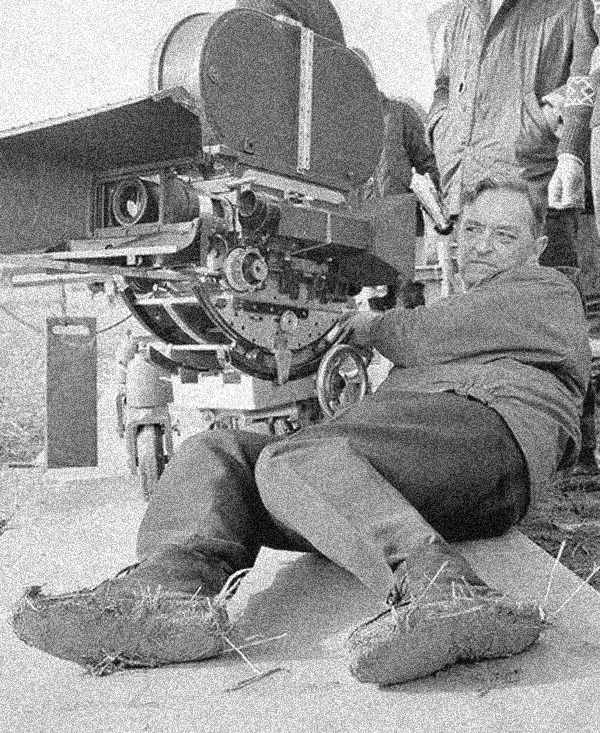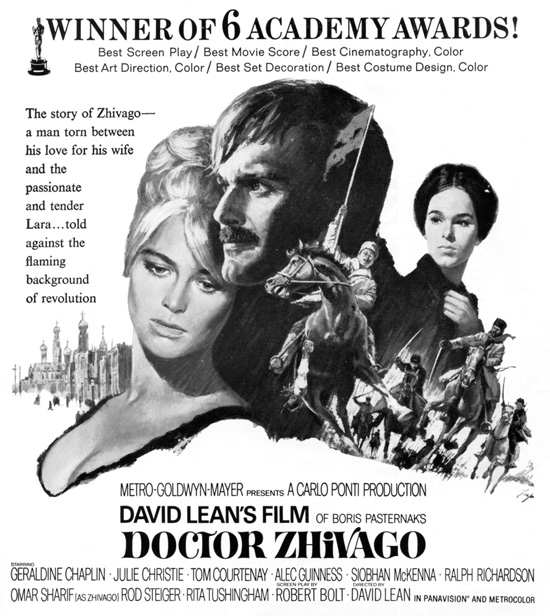Sir David Lean Forever |
Read more at in70mm.com The 70mm Newsletter |
| Written by: Mark Lyndon, in70mm.com London Correspondent | Date: 11.04.2021 |
 Lean
lines up a scene in Panavision. Director Lean stretches out alongside the
Panavision camera to line up an unusual shot for his film of Boris
Pasternak's "Doctor Zhivago". The director of the spectacular
Metro-Goldwyn-Mayer picture is the winner of two Academy Awards, while
"Doctor Zhivago" itself was awarded six "Oscars". From MGM press book, still
DZ-X-32. 1967 Lean
lines up a scene in Panavision. Director Lean stretches out alongside the
Panavision camera to line up an unusual shot for his film of Boris
Pasternak's "Doctor Zhivago". The director of the spectacular
Metro-Goldwyn-Mayer picture is the winner of two Academy Awards, while
"Doctor Zhivago" itself was awarded six "Oscars". From MGM press book, still
DZ-X-32. 1967Ten miles south of London, lies Croydon, one of the most prosperous and successful of towns. In gratitude, it celebrates the Arts, it enjoys a purpose built concert hall, The Fairfield Hall, with the finest acoustic in the land, according to Maestro Carl Davis. It boasts a theatre dedicated to the memory of Croydon’s most famous daughter Dame Peggy Ashcroft and a cinema dedicated to the renown of Croydon’s most illustrious son - Sir David Lean. Here, we especially celebrate Sir David Lean as a supreme champion of the format which brought the art of cinema to new heights - 70mm, naturally. It is well worth reviewing the milestones of the career which brought him to those heights. His career spanned six decades. By the end of the first, he had taught the world the vital importance of the Editor in film making. The nineteen thirties had witnessed a revolution in news gathering through the medium known as newsreel. Here was an immediacy and impact no other medium could compete with. Lean was the greatest exponent of creating that immediacy and impact, bringing to the screen, with economy and elegance, the great events of the times - The Great Depression, The Spanish Civil War, The Abdication Crisiis; all created through mastery of the art of editing. All this achieved before he directed his first film. Although uncredited, his first directing project was "Major Barbara", featuring a stellar cast, including future 70mm luminaries Rex Harrison and Robert Morley. Once again uncredited, he directed a wartime classic, "In Which We Serve", launching Richard Attenborough into the bargain. Noël Coward, may well have directed a few quips and witticisms during production, he got full credit as Director. Lean was granted his first credit as Director for "This Happy Breed", a Technicolor wartime morale booster, which gradually gained a reputation as a classic British film. His collaboration with Coward continued with "Blithe Spirit" and "Brief Encounter", a monumental success, which put him firmly in the Pantheon of the very greatest. Before the deacade was out, he brought two Dickens Classics, "Great Expectations" and "Oliver Twist" to the screen, they are unsurpassed to this day. The sheer poetic sensibility of the opening scenes of "Great Expectations", which featured the signature Lean shot, panning up to the branches of a windswept tree, was reprised in "Dr Zhivago", to the delight of the legion of Lean lovers. Some fine romances followed with "The Passionate Friends", "Madeleine", not his own favourite, and "Summertime", a love letter to Venice, which has never been more ravishingly portrayed. The superbly crafted crafted "Hobson’s Choice" and "The Sound Barrier" followed, to the delight of audiences. In 1957 a huge milestone in the history of the cinema, was reached with "The Bridge on the River Kwai", Lean’s first venture into widescreen. "Kwai" went on to win a constellation of international awards including 7 Oscars. He was the Best Director. What many consider to be the greatest and most influential film ever made, "Lawrence of Arabia" was released in 1962, winning another 7 Oscars. What could be written that has not been written? Or, to quote a line from scriptmeister Robert Bolt:
Columbia has recently released a 4K
transfer. For regular readers of this magazine, there is only one way to see
it, to do it justice, in 70mm, naturally. Technically, artistically and in
direction it remains the gold standard of film creation, never to be
surpassed until... |
More in 70mm reading: Facts For Editorial Reference About The Making Of Doctor Zhivago The Latest Word From METRO-GOLDWYN-MAYER on DAVID LEAN’S Film of DOCTOR ZHIVAGO. From The Novel By Boris Pasternak Restoration of "Lawrence of Arabia" "Ryan's Daughter" Revisited There Were Giants in the Land: Stanley Kubrick There Were Giants in the Land: Freddie Young Restored "Lawrence of Arabia" premieres Internet From Stanley Kubrick to Martin Scorsese: 5 iconic directors influenced by David Lean Steven Spielberg The Last Word goes to The Great Man himself |
 For many, "Doctor Zhivago"
was the greatest film ever made, the most romantic ever, surpassing even
Lean’s own "Brief Encounter". From landscapes to intimate scenes, he
was the true master of them all. It was screened in 70mm. Of course it
should have been shot in 65mm! From the Greatest Film Ever Made, to "The
Greatest Story Ever Told". Any lingering doubts that Lean was the
greatest artist working in the medium of 70mm film were dispelled by the
brooding atmosphere depicted in his fantastic landscapes. George Stevens
officially directed, but the best bits were the Lean bits. For many, "Doctor Zhivago"
was the greatest film ever made, the most romantic ever, surpassing even
Lean’s own "Brief Encounter". From landscapes to intimate scenes, he
was the true master of them all. It was screened in 70mm. Of course it
should have been shot in 65mm! From the Greatest Film Ever Made, to "The
Greatest Story Ever Told". Any lingering doubts that Lean was the
greatest artist working in the medium of 70mm film were dispelled by the
brooding atmosphere depicted in his fantastic landscapes. George Stevens
officially directed, but the best bits were the Lean bits.Now comes a very dark chapter in the story of this greatest of careers in film creation. "Ryan's Daughter" which was released in 1970, bore the torch for 65mm cinematography and 70mm prints, in spite of then fashionable notions. The tragedies depicted in this masterpiece were to be reflected in life. Great Works of art often attract monstrous vandals. Sculptures and famous monuments are smashed or decapitated. Great paintings are slashed and great films are trashed. Thus was it with "Ryan’s Daughter". Like a lynch mob, led by a pretentious trouble maker, the “critics” destroyed "Ryan's Daughter" and Lean’s career for the rest of the decade and beyond. It was written that David Lean lost confidence in himself as a film creator as a result of the virulent and vicious vandalism to which his work had been subjected. It is written that the hardest part of making a movie is finding the wherewithal to make it. Imagine depriving Rembrandt of paint and canvas, the great artist robbed and bereft of the tools of the trade. As far as serious crimes committed against Art are concerned, I rest my case. The years grew into their middle teens before he made another film. This passage which began in Croydon, ends with Dame Peggy and Sir David. Croydon’s most famous son and daughter were united in "A Passage to India", he directing, she starring. He ended the passage of his career as he had began it. He was the editor. Post Scriptum It is no exaggeration to say that without him, the art of film creation could not have progressed to what it is today. Think of Ridley Scott’s "Gladiator" and "The Kingdom of Heaven". He was above all, a director’s director. |
|
| Go: back - top - back issues - news index Updated 22-01-25 |
